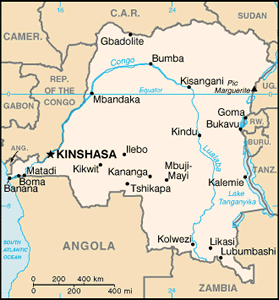The Geography of Congo, Democratic Republic of the
The Geography of Congo, Democratic Republic of the
Congolese or Congo Geography
Location: Central Africa, northeast of Angola
Geographic coordinates: 0 00 N, 25 00 E
Map references: Africa
Area: total: 2,345,410 sq km land: 2,267,600 sq km water: 77,810 sq km
Area - comparative: slightly less than one-fourth the size of the US
Land boundaries: total: 10,730 km border countries: Angola 2,511 km (of which 225 km is the boundary of Angola's discontiguous Cabinda Province), Burundi 233 km, Central African Republic 1,577 km, Republic of the Congo 2,410 km, Rwanda 217 km, Sudan 628 km, Tanzania 459 km, Uganda 765 km, Zambia 1,930 km
Coastline: 37 km
Maritime claims: territorial sea: 12 nm exclusive economic zone: boundaries with neighbors
Climate: tropical; hot and humid in equatorial river basin; cooler and drier in southern highlands; cooler and wetter in eastern highlands; north of Equator - wet season (April to October), dry season (December to February); south of Equator - wet season (November to March), dry season (April to October)
Terrain: vast central basin is a low-lying plateau; mountains in east
Elevation extremes: lowest point: Atlantic Ocean 0 m highest point: Pic Marguerite on Mont Ngaliema (Mount Stanley) 5,110 m
Natural resources: cobalt, copper, niobium, tantalum, petroleum, industrial and gem diamonds, gold, silver, zinc, manganese, tin, uranium, coal, hydropower, timber
Land use: arable land: 2.86% permanent crops: 0.47% other: 96.67% (2005)
Irrigated land: 110 sq km (2003)
Natural hazards: periodic droughts in south; Congo River floods (seasonal); in the east, in the Great Rift Valley, there are active volcanoes
Environment - current issues: poaching threatens wildlife populations; water pollution; deforestation; refugees responsible for significant deforestation, soil erosion, and wildlife poaching; mining of minerals (coltan - a mineral used in creating capacitors, diamonds, and gold) causing environmental damage
Environment - international agreements: party to: Biodiversity, Climate Change, Climate Change-Kyoto Protocol, Desertification, Endangered Species, Hazardous Wastes, Law of the Sea, Marine Dumping, Ozone Layer Protection, Tropical Timber 83, Tropical Timber 94, Wetlands signed, but not ratified: Environmental Modification
Geography - note: straddles equator; has narrow strip of land that controls the lower Congo River and is only outlet to South Atlantic Ocean; dense tropical rain forest in central river basin and eastern highlands


